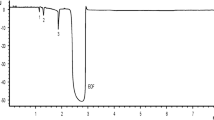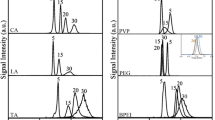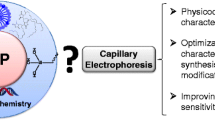Abstract
We report on the capillary electrophoretic behavior of citrate-capped gold and silver nanoparticles in aqueous medium when applying a ligand-exchange surface reaction with thiols. Gold nanoparticles (AuNPs) and silver nanoparticles (AgNPs) of similar size (39 ± 6 and 41 ± 7 nm, respectively) and shape were synthesized, covered with a citrate shell, and characterized by microscopic and spectroscopic techniques. The analysis of these NPs by CE was accomplished by using a buffer solution (pH 9.7; 40 mM SDS, 10 mM CAPS; 0.1 % methanol) containing the anions of thioctic acid or thiomalic acid. These are capable of differently interacting with the surface of the AuNPs and AgNPs and thus introducing additional negative charges. This results in different migration times due to the formation of differently charged nanoparticles.

Capillary electrophoretic behavior of citrate-capped gold and silver nanoparticles (NPs) in aqueous medium when applying a ligand-exchange surface reaction with thiols (thioctic and thiomalic acids), which introduces additional negative charges, has been studied




Similar content being viewed by others
References
Cai W, Gao T, Hong H, Sun J (2008) Applications of gold nanoparticles in cancer nanotechnology. Nanotechnol Sci Appl 1:17
Sperling RA, Rivera-Gil P, Zhang F, Zanella M, Parak WJ (2008) Biological applications of gold nanoparticles. Chem Soc Rev 37:1896
Eustis S, El-Sayed MA (2006) Why gold nanoparticles are more precious than pretty gold: noble metal surface plasmon resonance and its enhancement of the radiative and nonradiative properties of nanocrystals of different shapes. Chem Soc Rev 35:209
López-Lorente AI, Simonet BM, Valcárcel M, Mizaikoff B (2013) Bare gold nanoparticles mediated surface-enhanced Raman spectroscopic determination and quantification of carboxylated single-walled carbon nanotubes. Anal Chim Acta 788:122
Volkert AA, Subramaniam V, Ivanov MR, Goodman AM, Haes AJ (2011) Salt-mediated self-assembly of thioctic acid on gold nanoparticles. ACS Nano 5:4570
Kato H, Suzuki M, Fujita K, Horie M, Endoh S, Yoshida Y, Iwahashi H, Takahashi K, Nakamura A, Kinugasa S (2009) Reliable size determination of nanoparticles using dynamic light scattering method for in vitro toxicology assessment. Toxicol In Vitro 23:927
Wei GT, Liu FK (1999) Separation of nanometer gold particles by size exclusion chromatography. J Chromatogr A 836:253
Baalousha M, Stolpe B, Lead JR (2011) Flow field-flow fractionation for the analysis and characterization of natural colloids and manufactured nanoparticles in environmental systems: a critical review. J Chromatogr A 1218:4078
López-Lorente AI, Simonet BM, Valcárcel M (2011) Electrophoretic methods for the analysis of nanoparticles. TrAC Trends Anal Chem 30:58
Li L, Yu H, Liu D, You T (2013) A novel dark-field microscopy technique coupled with capillary electrophoresis for visual analysis of single nanoparticles. Analyst 138:3705
Liu FK, Tsai MH, Hsu YC, Chu TC (2006) Analytical separation of Au/Ag core/shell nanoparticles by capillary electrophoresis. J Chromatogr A 1133:340
Chang TH, Liu FK, Chang YC, Chu TC (2008) Rapidly characterizing the growth of Au nanoparticles by CE. Chromatographia 67:723
Liu FK, Lin YY, Wu CH (2005) Highly efficient approach for characterizing nanometer-sized gold particles by capillary electrophoresis. Anal Chim Acta 528:249
Lin KH, Chu TC, Liu FK (2007) On-line enhancement and separation of nanoparticles using capillary electrophoresis. J Chromatogr A 1161:314
Liu FK, Ko FH, Huang PW, Wu CH, Chu TC (2005) Studying the size/shape separation and optical properties of silver nanoparticles by capillary electrophoresis. J Chromatrogr A 1062:139
Arnaud I, Abid JP, Roussel C, Girault HH (2005) Size-selective separation of gold nanoparticles using isoelectric focusing electrophoresis (IEF). Chem Commun 787
Gole AM, Sathivel C, Lachke A, Sastry M (1999) Size separation of colloidal nanoparticles using a miniscale isoelectric focusing technique. J Chromatogr A 848:485
Bardelmeijer HA, Lingeman H, de Ruiter C, Underberg WJ (1998) Derivatization in capillary electrophoresis. J Chromatogr A 807:3
Badia A, Lennox RB, Reven L (2000) A dynamic view of self-assembled monolayers. Acc Chem Res 33:475
Zhu T, Vasilev K, Kreiter M, Mittler S, Knoll W (2003) Surface modification of citrate-reduced colloidal gold nanoparticles with 2-mercaptosuccinic acid. Langmuir 19:9518
Bücking W, Nann T (2006) Electrophoretic analysis of gold nanoparticles: size-dependent electrophoretic mobility of nanoparticles. IEE Proc Nanobiotechnol 153:47
Paau MC, Lo CK, Yang X, Choi MMF (2009) Capillary electrophoretic study of thiolated α-cyclodextrin-capped gold nanoparticles with tetraalkylammonium ions. J Chromatogr A 1216:8557
Lo CK, Paau MC, Xiao D, Choi MMF (2008) Application of capillary zone electrophoresis for separation of water-soluble gold monolayer-protected clusters. Electrophoresis 29:2330
Xu X, Caswell KK, Tucker E, Kabisatpathy S, Brodhacker KL, Scrivens WA (2007) Size and shape separation of gold nanoparticles with preparative gel electrophoresis. J Chromatogr A 1167:35
Hanauer M, Pierrat S, Zins I, Lotz A, Sönnichsen C (2007) Separation of nanoparticles by gel electrophoresis according to size and shape. Nano Lett 7:2881
Turkevich J, Stevenson PC, Hillier J (1951) A study of the nucleation and growth processes in the synthesis of colloidal gold. Discus Faraday Soc 11:55
López-Lorente AI, Simonet BM, Valcárcel M (2012) Rapid analysis of gold nanoparticles in liver and river water samples. Analyst 137:3528
Lee PC, Meisel D (1982) Adsorption and surface-enhanced Raman of dyes on silver and gold sols. J Phys Chem 86:3391
Hostetler MJ, Wingate JE, Zhong CJ, Harris JE, Vachet RW, Clark MR, Londono JD, Green SJ, Stokes JJ, Wignall GD, Glish GL, Porter MD, Evans ND, Murray RW (1998) Alkanethiolate gold cluster molecules with core diameters from 1.4 to 5.2 nanometers: core and monolayer properties as a function of core size. Langmuir 14:17
Liu FK, Chang YC (2010) Using thiol-capped gold nanoparticles in the background solution of MEKC to concentrate and separate neutral steroids. Chromatographia 72:1129
Abad JM, Mertens SFL, Pita M, Fernandez VM, Schiffrin DJ (2005) Functionalization of thioctic acid-capped gold nanoparticles for specific immobilization of histidine-tagged proteins. J Am Chem Soc 127:5689
Tournebize J, Boudier A, Sapin-Minet A, Maincent P, Leroy P, Schneider R (2012) Role of gold nanoparticles capping density on stability and surface reactivity to design drug delivery platforms. ACS Appl Mater Interfaces 4:5790
Love JC, Estroff LA, Kriebel JK, Nuzzo RG, Whitesides GM (2005) Self-assembled monolayers of thiolates on metals as a form of nanotechnology. Chem Rev 105:1103
Felice RD, Selloni A (2004) Adsorption modes of cysteine on Au(111): thiolate, amino-thiolate, disulfide. J Chem Phys 120:4906
Dubois LH, Nuzzo RG (1992) Synthesis, structure, and properties of model organic surfaces. Annu Rev Phys Chem 43:437
Acknowledgments
The authors wish to thank Spain’s Ministry of Innovation and Science for funding Project CTQ2011-23790 and Junta de Andalucía for Project FQM4801. A.I. López-Lorente also wishes to thank the Ministry for the award of a Research Training Fellowship (Grant AP2008-02939).
Conflict of interest
The authors declare no competing financial interest.
Author information
Authors and Affiliations
Corresponding author
Electronic supplementary material
Below is the link to the electronic supplementary material.
ESM
(PDF 687 KB)
Rights and permissions
About this article
Cite this article
López-Lorente, Á.I., Soriano, M.L. & Valcárcel, M. Analysis of citrate-capped gold and silver nanoparticles by thiol ligand exchange capillary electrophoresis. Microchim Acta 181, 1789–1796 (2014). https://doi.org/10.1007/s00604-014-1218-5
Received:
Accepted:
Published:
Issue Date:
DOI: https://doi.org/10.1007/s00604-014-1218-5




